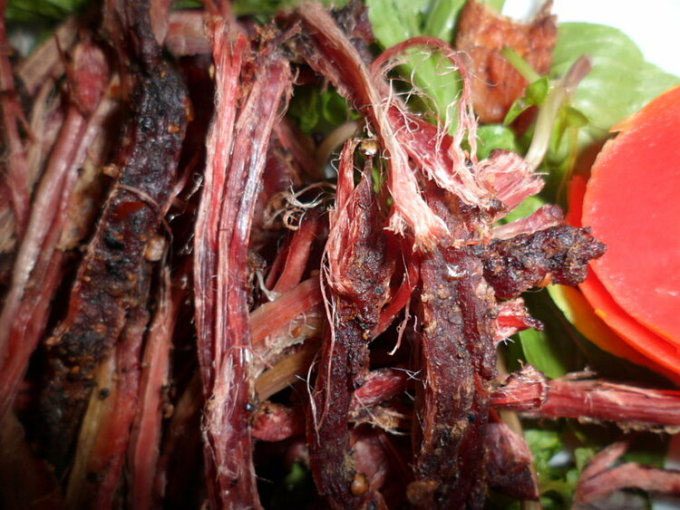Beef jerky is a popular dish during the Lunar New Year, but it can pose health risks if it is heavily seasoned with additives or not smoked properly.
Tips for Choosing Quality Beef Jerky
Beef jerky is favored during the Lunar New Year for its delicious taste, chewy texture, and smoky aroma, making it an ideal treat for guests. Associate Professor Dr. Nguyen Duy Thinh, former staff member of the Food Biotechnology Institute at Hanoi University of Science and Technology, states that smoked beef, or jerky, is a traditional food that has existed for a long time.
Typically, smoked meats are hung high, and during the process of burning wood, smoke is generated, containing beneficial antibacterial properties that help inhibit microorganisms, thus extending the meat’s shelf life. Not only buffalo meat but also beef and pork are preserved in this manner by people in the Northwestern regions, creating a distinctive culinary experience.
In reality, many places producing this meat do so manually, lacking food safety standards, without inspection, and without expiration dates, posing various health risks:
Risks of Containing Additives
Processing facilities often use low-quality meat and then add additives or chemical flavorings to enhance the dish’s taste, which can lead to allergies or food poisoning. Additionally, there are cases where pork is used to mimic buffalo meat. Fake jerky often uses numerous additives to alter the color and flavor, posing significant risks to consumers.
Improper Smoking Techniques
Beef jerky is made from raw meat that has not undergone thorough processing, so food safety is a major concern. The smoking process must adhere to the correct duration, but many production facilities shorten the smoking time, resulting in unevenly cooked meat, with some parts properly smoked while others remain undercooked. Parts of the meat that do not receive smoke may not be fully cooked and could easily develop mold and microorganisms, posing health hazards.

Shredded beef jerky. (Photo: Blogspot).
Experts point out three key aspects that consumers need to consider when purchasing beef jerky for the Lunar New Year:
Color and Size
Quality beef jerky has a dark black exterior, while the inside displays a vibrant pink color. The ideal size is 12-15 cm long, about 6-8 cm wide, and 2-3 cm thick. When prepared, it should be pounded and shredded before consumption, revealing its elasticity without crumbling apart.
If the beef jerky is counterfeit, it will likely lack the vibrant pink color and instead appear pale if frozen or dark red if made from pork (especially from sows). Shredded meat will lack chewiness and can easily crumble.
Flavor
Genuine beef jerky is made from fresh buffalo meat, offering a sweet taste complemented by the fragrant spices from the Northwest. In contrast, if the jerky is counterfeit, it will not provide the sweet meat flavor but rather a strong overpowering spice aroma.
Price
Quality beef jerky and pork jerky are typically priced quite high in the market, while products sold at substantially lower prices are likely counterfeit or made from substandard ingredients. Generally, producing 1 kg of beef jerky requires about 3 kg of fresh buffalo meat, making it impossible to offer at a low cost, not to mention labor and other ingredient expenses.
In conclusion, when buying beef jerky for the Lunar New Year, pay attention to its origin, production facilities, pricing, color, and flavor. Additionally, moderation is key, as consuming too much can be detrimental to your health.


















































